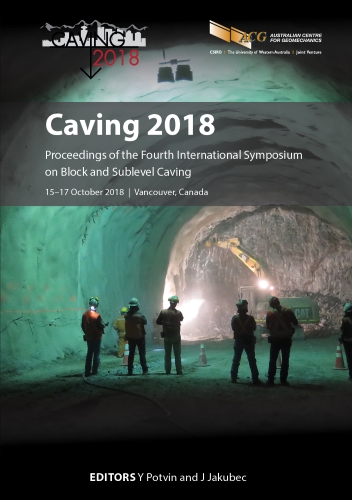Development of a monitoring network for surface subsidence at New Gold's New Afton block cave operation

|
Authors: Clayton, MA; Dugie, M; LeRiche, A; McKane, C; Davies, AGL |
DOI https://doi.org/10.36487/ACG_rep/1815_53_Clayton
Cite As:
Clayton, MA, Dugie, M, LeRiche, A, McKane, C & Davies, AGL 2018, 'Development of a monitoring network for surface subsidence at New Gold's New Afton block cave operation', in Y Potvin & J Jakubec (eds), Caving 2018: Proceedings of the Fourth International Symposium on Block and Sublevel Caving, Australian Centre for Geomechanics, Perth, pp. 689-704, https://doi.org/10.36487/ACG_rep/1815_53_Clayton
Abstract:
New Gold’s New Afton mine is a six million tonne per year operating mine located 8 km southwest of Kamloops, British Columbia, Canada. The current mining lift is approximately 600 m below ground, partially beneath the historical Afton pit. The subsidence zone at New Afton has developed asymmetrically and has deviated from the initial feasibility study modelling estimates. The growth of the subsidence zone extents is now being monitored in consideration of the mine’s surface infrastructure. The subsidence monitoring system at New Afton has been developed in phases in response to project needs. Initially, monitoring was setup to track the predicted cave growth and surface deformation near the crater. The monitoring network was expanded to areas away from the crater using additional instruments of various types. An automated data collection and retrieval system was implemented, with existing electrical instruments retrofitted to collect and transmit data automatically to the mine’s database. Drilling completed to install these instruments allowed collection of new subsurface information used to refine the geological model, thus improving the mine’s understanding of subsidence progression. In addition to providing information necessary for day-to-day mine operations, data collected from this monitoring system allow for refinement of predictions of future subsidence. The different data types each come with limitations and interpretation challenges. This paper discusses the development of the monitoring network, along with instrument selection criteria and performance information for New Afton.
Keywords: monitoring, instrumentation, subsidence
References:
Baker, DG 1991, ‘Wahleach power tunnel monitoring’, Field Measurements in Geotechnics, A.A. Balkema, Rotterdam, pp. 467–497.
Lipske, J & Wade, D 2014, Geological Model of the New Afton Copper and Gold Deposit, British Columbia, internal report, New Gold Inc., Vancouver.
Logan, JM & Mihalynuk, MG 2005, ‘Porphyry Cu-Au Deposits of the Iron Mask Batholith, Southeastern British Columbia’, Geological Field Work 2004, British Columbia Geological Survey, Vancouver, paper 2005-1.
Mikkelsen, PE 2003, ‘Advances in inclinometer data analysis’, in F Myrvoll (ed.), Proceedings of the 6th International Symposium on Field Measurements in Geomechanics, CRC Press, Boca Raton, pp. 555–567.
van As, A, Davison, J & Moss, A 2003, Subsidence Definitions for Block Caving Mines, technical report, Rio Tinto Technical Services.
Woo, K 2011, Characterization and Analysis of Discontinuous Subsidence Associated with Block Cave Mining Using Advanced Numerical Modelling and InSAR Deformation Monitoring, The University of British Columbia, Vancouver.
© Copyright 2026, Australian Centre for Geomechanics (ACG), The University of Western Australia. All rights reserved.
View copyright/legal information
Please direct any queries or error reports to repository-acg@uwa.edu.au
View copyright/legal information
Please direct any queries or error reports to repository-acg@uwa.edu.au
